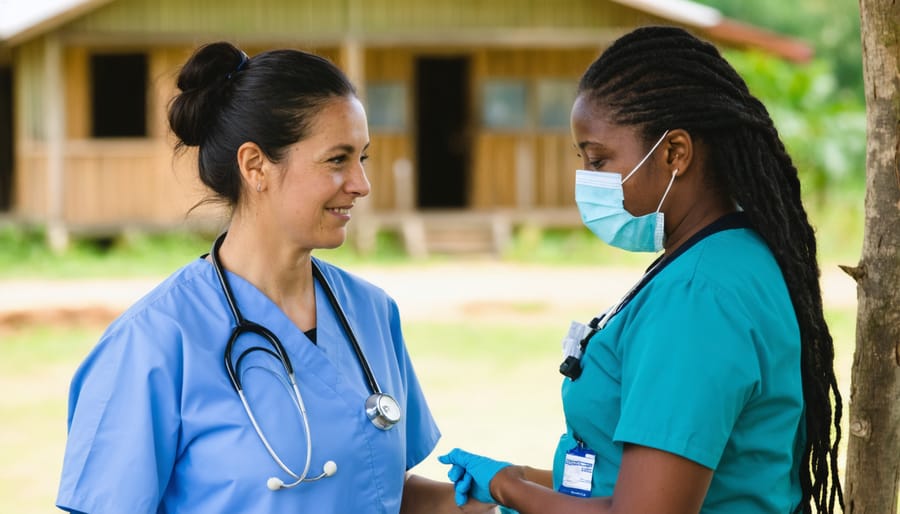Identifying and supporting at-risk populations requires immediate community action to protect our most vulnerable neighbors. In Alberta, these groups include seniors living alone, individuals with chronic health conditions, Indigenous communities facing healthcare barriers, and people experiencing homelessness or poverty. Their challenges range from limited healthcare access to increased susceptibility to diseases, creating a complex web of health and social needs that demand our attention.
Despite making up a significant portion of our population, at-risk groups often remain invisible until crisis strikes. Understanding who these vulnerable populations are and recognizing their unique challenges marks the first step toward building a more resilient, inclusive healthcare system. Whether you’re a healthcare provider, community leader, or concerned citizen, knowing how to identify and support at-risk individuals can make a crucial difference in their health outcomes and quality of life.
Together, we can create stronger support networks and ensure every Albertan has access to the care and resources they need to thrive.
Who Are Alberta’s At-Risk Populations?
Seniors and the Elderly
Alberta’s seniors, aged 65 and older, face unique health challenges that can increase their vulnerability to various conditions. Common risks include reduced mobility, social isolation, and multiple chronic health conditions. With age-related changes in immune function, seniors are more susceptible to infections and complications from illnesses like flu and pneumonia. The process of managing chronic diseases in seniors requires special attention, particularly when dealing with conditions like diabetes, heart disease, and arthritis. Living alone, limited access to transportation, and financial constraints can also impact seniors’ ability to maintain regular medical appointments and healthy lifestyles. However, with proper support systems and preventive care, many seniors can maintain their independence and quality of life while effectively managing their health conditions.

Indigenous Communities
Indigenous communities in Alberta face unique health challenges influenced by historical, social, and economic factors. First Nations, Métis, and Inuit peoples experience higher rates of chronic conditions like diabetes, heart disease, and respiratory issues compared to non-Indigenous populations. Limited access to healthcare services, particularly in remote communities, creates additional barriers to preventive care and treatment.
Food security and access to traditional foods also impact health outcomes. Many Indigenous communities face challenges maintaining traditional dietary practices while adapting to modern food systems. Mental health concerns, including intergenerational trauma, require culturally appropriate support services.
However, Indigenous communities demonstrate remarkable resilience through traditional healing practices, community-led health initiatives, and cultural revitalization programs. Local organizations work alongside Indigenous leaders to develop culturally sensitive healthcare solutions that respect traditional knowledge while addressing contemporary health challenges.
Low-Income Individuals and Families
Financial hardship can significantly impact health outcomes, creating barriers to accessing healthcare, nutritious food, and safe housing. In Alberta, individuals and families living below the low-income cut-off often face challenges maintaining their health due to limited resources. These challenges may include postponing medical appointments, difficulty affording prescription medications, and choosing between basic necessities like food and utilities.
Living with financial stress can also lead to increased anxiety and depression, making it harder to maintain healthy lifestyle habits. The cycle of poverty and poor health can be particularly challenging to break without support. However, Alberta offers various programs and resources to help, including prescription coverage through Alberta Health Benefits, subsidized housing programs, and community food banks. Understanding and accessing these support systems is crucial for improving health outcomes and breaking the connection between low income and increased health risks.
Common Health Risks in Alberta

Chronic Disease Prevalence
Chronic diseases significantly impact many Albertans, with rates continuing to rise across the province. Currently, about 8.1% of adults in Alberta live with diabetes, while nearly one in four manages high blood pressure. Heart disease affects approximately 6% of the adult population, making it a leading cause of hospitalization.
These conditions often occur together, with many individuals managing multiple chronic health challenges simultaneously. For example, people with diabetes are two to four times more likely to develop heart disease compared to those without diabetes.
Other prevalent chronic conditions in Alberta include:
– Arthritis (affecting about 20% of adults)
– Asthma (roughly 8% of the population)
– Chronic obstructive pulmonary disease (COPD) (approximately 4% of adults)
While these statistics might seem concerning, it’s important to note that many chronic diseases are preventable through lifestyle modifications. Regular physical activity, healthy eating habits, and routine medical check-ups can significantly reduce your risk. Understanding your family history and working closely with healthcare providers can help you develop an effective prevention strategy or management plan if you’re already living with a chronic condition.
Remember, early detection and proactive management are key to maintaining a good quality of life while living with chronic conditions.
Mental Health Challenges
Mental health challenges significantly impact many at-risk populations in Alberta, with anxiety, depression, and stress being common concerns. These issues often intertwine with other health conditions, creating complex barriers to overall wellbeing. Indigenous communities, newcomers, and individuals facing economic hardship are particularly vulnerable to mental health struggles due to various social and cultural factors.
The isolation and uncertainty many experience can lead to decreased access to healthcare services and support networks. However, implementing effective mental health support strategies can make a meaningful difference. Community-based programs, cultural healing practices, and accessible counselling services have shown promising results in supporting mental wellness.
It’s important to recognize that mental health challenges are treatable, and seeking help is a sign of strength. Local health centers, crisis hotlines, and support groups across Alberta offer various resources to help individuals cope with and overcome these challenges while respecting their unique circumstances and needs.
Lifestyle-Related Risks
Our daily choices significantly influence our health risks. Poor dietary habits, like consuming excessive processed foods and sugary drinks, can lead to obesity, diabetes, and heart disease. Physical inactivity is particularly concerning in Alberta, where long winters can make regular exercise challenging. Studies show that adults who sit for more than 8 hours daily face increased health risks, even if they exercise regularly.
Environmental factors also play a crucial role. Exposure to second-hand smoke, air pollution, and workplace hazards can increase the risk of respiratory issues and other health conditions. Urban Albertans may face different environmental challenges compared to rural residents, from air quality concerns to varying access to healthy food options.
The good news is that these risks are largely modifiable. Small changes like taking regular breaks from sitting, choosing whole foods over processed options, and being mindful of environmental exposures can significantly reduce your health risks. Even modest improvements in lifestyle habits can lead to better health outcomes.
Support and Resources Available
Healthcare Programs
Alberta offers several targeted healthcare programs designed to support at-risk populations. The Alberta Health Care Insurance Plan (AHCIP) provides essential medical coverage, while specialized programs address specific needs of vulnerable groups.
The Aboriginal Health Program delivers culturally appropriate care and support services to Indigenous communities, including traditional healing practices and community-based wellness initiatives. For seniors and those with disabilities, the Special Needs Assistance program helps cover medical equipment and essential health-related expenses.
Low-income Albertans can access the Alberta Adult Health Benefit, which covers prescription medications, dental care, optical services, and diabetic supplies. The Mental Health Patient Advocate program ensures individuals with mental health challenges receive appropriate care and support.
The Chronic Disease Management program provides comprehensive care for those managing ongoing health conditions, offering education, monitoring, and regular check-ups. Additionally, the Outreach Program connects vulnerable populations with healthcare services through mobile clinics and community health workers.
These programs aim to reduce healthcare barriers and improve health outcomes for at-risk populations through accessible, culturally sensitive, and comprehensive care solutions.
Community Support Services
Alberta offers numerous support services to help at-risk populations access essential resources and care. The Alberta Health Services (AHS) operates community health centers throughout the province, providing free or low-cost medical care, health education, and preventive services.
Local food banks, including the Edmonton and Calgary Food Banks, help address food insecurity through emergency food hampers and connection to long-term support programs. The Alberta Works program assists with income support, employment services, and health benefits for eligible individuals.
Organizations like the Mustard Seed and Hope Mission provide shelter services, addiction recovery programs, and mental health support. The Canadian Mental Health Association’s Alberta Division offers counseling services and support groups in various communities.
211 Alberta serves as a comprehensive information hub, connecting individuals with community, social, and government services 24/7. Many communities also have neighborhood resource centers offering programs specifically designed for seniors, newcomers, and individuals with disabilities.

Prevention Strategies
Taking proactive steps to protect your health is essential, especially if you belong to an at-risk group. Start by establishing a regular schedule for health check-ups and screenings with your healthcare provider. Make healthy lifestyle choices like maintaining a balanced diet rich in fruits, vegetables, and whole grains, and aim for at least 150 minutes of moderate physical activity each week.
Consider joining local chronic disease prevention programs that offer structured support and guidance. Build strong social connections within your community, as social support plays a crucial role in maintaining both physical and mental well-being.
Stay up-to-date with vaccinations and preventive care recommendations specific to your risk factors. Create an emergency health plan, including important contact numbers and medication lists. Don’t hesitate to reach out to local support groups or community health services for additional resources and guidance in managing your health risks.
Understanding and supporting at-risk populations in Alberta is crucial for building a healthier, more resilient community. Throughout this article, we’ve explored the various groups who face increased health challenges and the specific factors that contribute to their vulnerability. From seniors and individuals with chronic conditions to Indigenous communities and those facing socioeconomic barriers, each group requires targeted support and resources to improve their health outcomes.
Remember, being part of an at-risk population doesn’t mean negative health outcomes are inevitable. By taking proactive steps and accessing available resources, individuals can significantly improve their health and well-being. Alberta offers numerous support programs, healthcare services, and community initiatives designed specifically to help vulnerable populations thrive.
If you identify with any of the at-risk groups discussed, we encourage you to reach out to the support services mentioned and take advantage of the preventive measures available to you. For family members, friends, and caregivers, your role in supporting at-risk individuals is invaluable. By staying informed and engaged, you can help create a stronger support network for those who need it most.
Let’s work together to break down barriers to healthcare access and create more inclusive, supportive communities across Alberta. Whether you’re directly affected or want to help others, every action counts. Start today by connecting with local health services, joining support groups, or volunteering with organizations that serve vulnerable populations. Together, we can build a healthier future for all Albertans.

